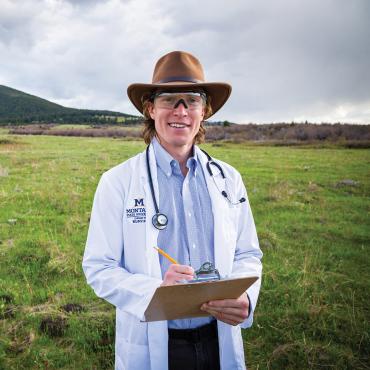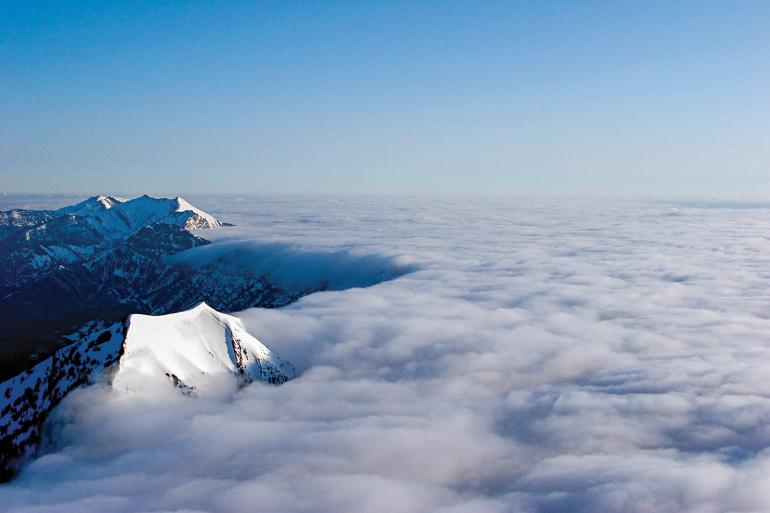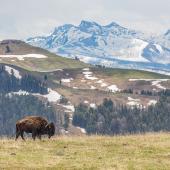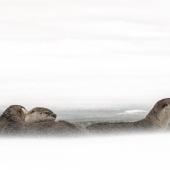Upside-Down Air
Wintertime temperature inversions explained.
You’ve seen it before: on the morning after a cold, calm winter night with glistening stars, a flat layer of clouds forms above the valley. The temperature is frigid—well below zero—but you decide to tough it out and go skiing. As you’re riding the chairlift, you suddenly burst through to a clear, sunny sky, and you’re not shivering anymore. Below you, the clouds sprawl out flat as a pancake. You’ve heard this called a temperature inversion, because normally, the air gets colder as you go higher up the mountain, not warmer. But what’s going on? Why do temperature inversions happen here in the winter?
Under average conditions, Earth’s atmosphere cools by about five degrees Fahrenheit for every 1,000 feet gained in elevation. This is known as the adiabatic lapse rate, and it occurs primarily because the atmosphere is heated by warmth emitted from the ground (more on that shortly). Thus, the warmest air is closest to the ground.
But a very cold winter night is not an average condition. So in this case, things turn upside-down—literally. To understand this, let’s take a closer look at how Earth’s atmosphere is heated.
Earth’s atmosphere is primarily heated by radiation, which entails the absorption of electromagnetic waves by the atmosphere’s gas molecules—just like food heating up in the microwave. The sun is the ultimate source of radiation in Earth’s atmosphere, but not directly. Here’s why: powerful sources of radiation, like the sun, produce short-wavelength electromagnetic waves. Molecules are picky about what wavelengths of radiation they absorb, and the atmosphere’s gas molecules don’t absorb the sun’s short-wavelength radiation.
In essence, the ground is cooling the air instead of heating it, and voila! We have a temperature inversion.
Instead, the sun’s radiation passes through the atmosphere and is absorbed by the ground, causing the ground to heat up. As the ground heats, it emits its own radiation, but because this radiation source is much less powerful than the sun, the electromagnetic waves occur at a long wavelength. Turns out, this long-wavelength radiation is absorbed by gasses in the atmosphere. Radiation is strongest at the closest distance to its source, so the air nearest to the ground receives the most heat.
Not only does the warm ground heat low-lying air by radiation, but also by conduction: direct heat transfer via physical contact between the air and ground, like your hand touching the handle of a hot skillet. Radiation and conduction from the ground can usually continue heating air after the sun goes down, which is why even at night, air closest to the ground is usually still the warmest.
But in the depths of winter, this process turns on its head, because the ground is absorbing so little solar radiation. This is due to both the sun’s lower angle in winter, and the reflection of sunlight off snow. The fallout is two-fold: first, the ground’s temperature falls, and subsequently, the ground emits much less radiation into the atmosphere. During the daytime, enough solar radiation is still absorbed by the ground to heat low-lying air, but barely. So, throughout a long winter’s night, the ground expends its radiation stores; thus, the low-lying air is no longer being heated. And because the ground itself is cold, we reach a tipping point: the conduction of heat between the ground and air reverses, which drastically cools the air closest to the ground. In essence, the ground is cooling the air instead of heating it, and voila! We have a temperature inversion.
The fog that’s often associated with inversions is the result of water vapor condensing or freezing in the cold air. Think about it: clouds normally reside high above Earth’s surface, where the air is colder. In an inversion, the coldest air is near the ground, so clouds form near the ground. Simple as that. Throughout the day, the sun’s radiation warms the cloud layer, causing it to “burn off,” and the inversion disappears.
In flat country, this effect may be confined to a low layer of fog on the ground. But in our mountainous terrain, cold air from the high peaks spills down into the valleys and piles up as it condenses at night, resulting in thick inversion layers that may encapsulate all but the highest ground. And on those mornings, if you go high enough, you’ll be treated to a splendid sea of white spilling out beneath you—along with warmer temps, to boot.
Unlike Earth’s atmosphere, Jack Taylor’s energy level increases when the radiation emitted by Earth’s surface is minimal, due to the resulting prevalence of cold, dry, powdery snow.












